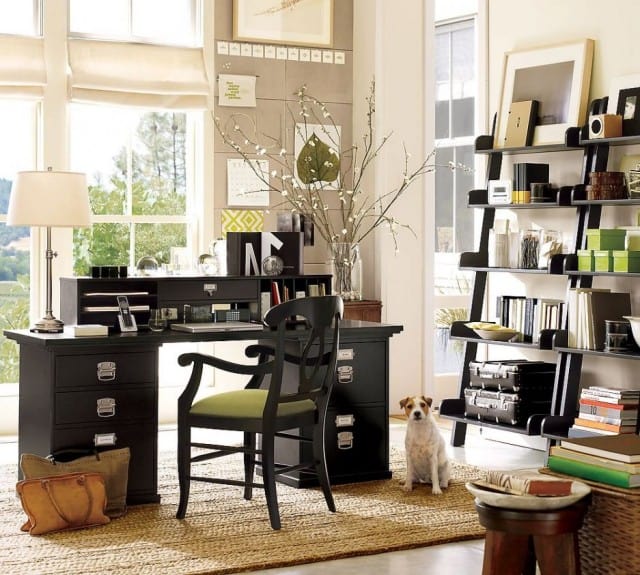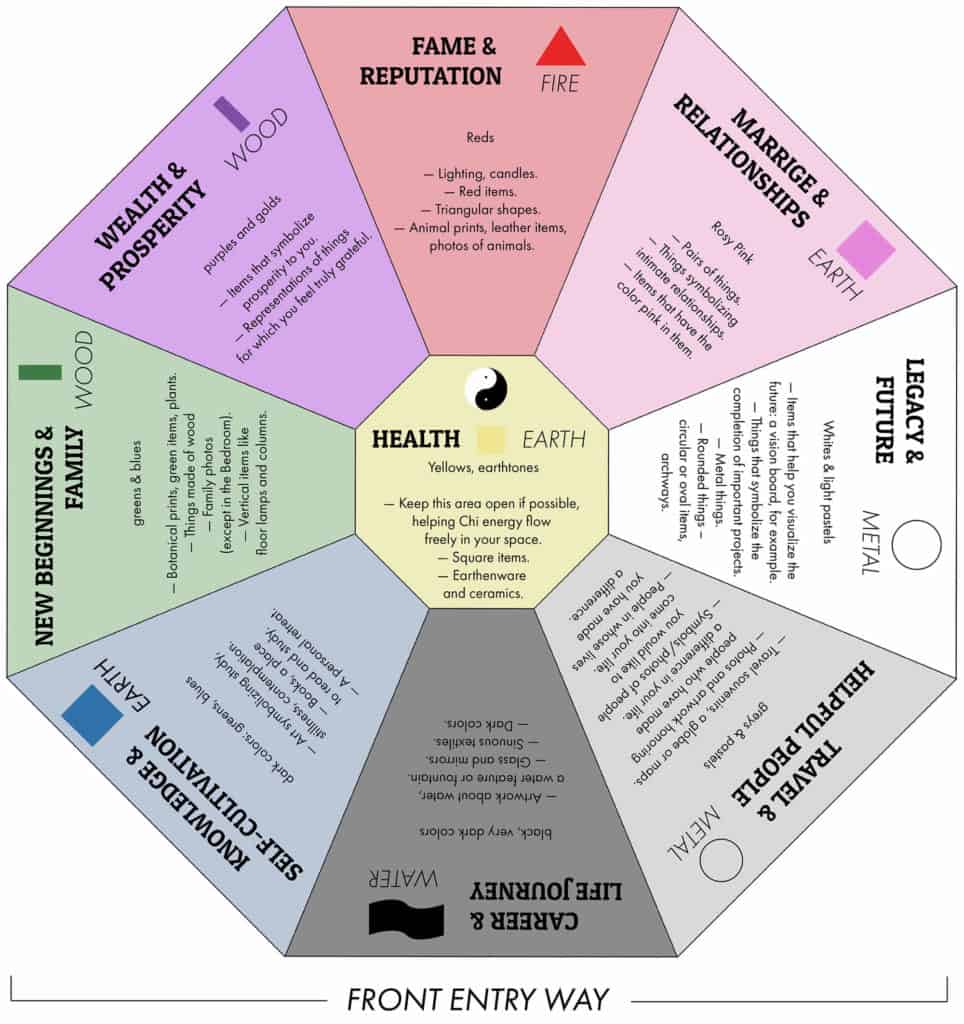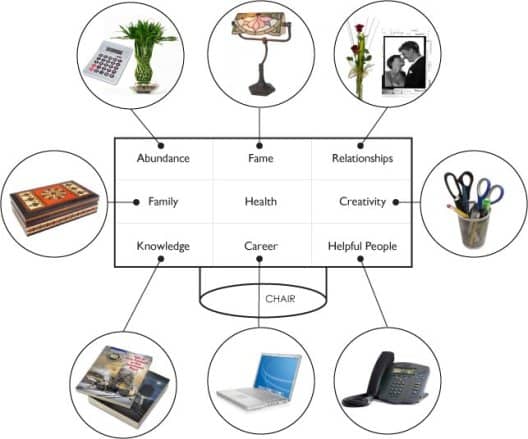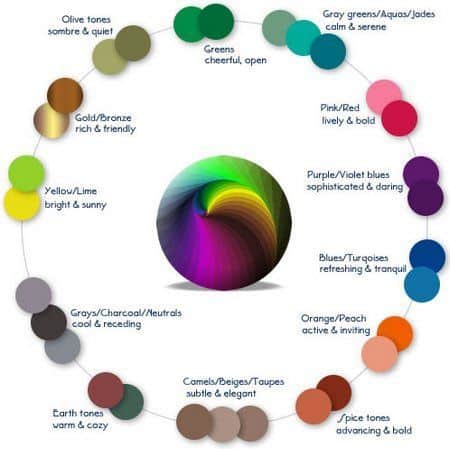Creating a home office that follows Feng Shui guidelines is said to promote prosperity and good fortune. In order to develop such a space, I have done the research to ensure that your office is properly Feng Shuied. Utilizing this guide may provide the office and those in it with success.
How do you use Feng Shui to design a h
If you are in doubt regarding the results of Feng Shui, perhaps an explanation of the history and effectiveness will convince you. Knowing the how and why of Feng Shui is important to achieving good results with the concept.
Following the rules of Feng Shui can help your office in a variety of ways. If you are a believer in chi, Feng Shui is sure to improve your energy flow and the flow that is within your home office. If you are a non-believer of the claimed effects of Feng Shui, following the proposed guidelines will at the very least give you an attractive office space.
An office space that improves upon functionality and productivity is the goal for most businesses. Even if you are a skeptic, putting Feng Shui practices to use will help to achieve that goal. While the reason behind the improvement might be a result of something other than the energy flow, the improvement is the aspect that matters.

Feng Shui the Home Office
Bringing Feng Shui into your office space is said to improve on productivity levels, increase comfort, and boost happiness. All of these benefits of Feng Shui seem like worthwhile reasons to give it a try. By following the three principles of Feng Shui, you may see a noticeable change in the office.
The first principle of Feng Shui is energy flow. This energy is also known as chi. In order to allow good flow, the office must be set up to allow it to move effortlessly and smoothly. Effortless movement is encouraged with an organized environment, an open layout, and soft edges on furniture.
rganization is key to proper Feng Shui. A desk’s surface should be at least half clear. Clutter or too much work stacked up on a workstation is said to disrupt the flow of energy. It also causes difficulty in finding needed items and documents in a timely manner. By hiding away any electrical cords and ensuring that paperwork is completed in a timely manner, there is a better chance that energy will not get stuck on the mess.
Electrical cords can best be hidden with zip ties or cord hooks. Some people have expressed success with simple hacks like painted or decorated paper towel rolls or binder clips. Organizing paperwork into folders and placed in drawers will help to keep the desk area clear.
The layout of the room is a key element for Feng Shui. First and foremost, there needs to be adequate space to move around. Narrow walkways will congest negative energy and prohibit the easy flow of positive energy, so ensuring several feet between desks or other furniture will allow for improved flow of chi.
The office layout is also important in deciding where to place desks and how they might be arranged. Negative energy can come from a desk that is facing a wall or a window, in line with the door, or with your back to the door. Knowing these truths leaves the best placement for your desk to be facing the door in what is known as the commanding position and not in line with the door. This should leave a wall at your back, which is also where a focal point should be found.
The furniture used should not have any sharp edges, as energy can also get easily stuck on corners. A desk with rounded corners allows for the best energy flow in a corporate office. Chairs that curve, rather than meet at a corner does the same. Smooth lines also provide a fun aesthetic, which is a huge benefit to Feng Shui.
Incorporating a good energy flow is only the first step in Feng Shui. Accomplishing the above-mentioned design tips will allow for the proper flow of positive energy and thus achieving the best working environment.
The second major point in Feng Shui is incorporating natural elements. Finding balance in the elements: wood, earth, metal, fire, and water can be represented in different ways. The literal translation of Feng Shui is wind and water, which is said to speak for good health and fortune. However, it is ideal to have an equal representation of each element so as not to give too much power to one element, not even water.

Too much of an element is said to cause problems that are specific to each one, as could too little. A room with too much water representation can cause depression and weight gain, as could too little fire. However, on the flip side, too many fire components may cause anger and frustration. A lack of water representation in a space might cause stunted career growth and financial hardships.
Determining the perfect balance of the elements may take some experimentation, but is possible with practice. If you struggle
If you find that you are unable to concentrate or are disorganized, removing some metal components may help your focus. Health problems may require the addition of wood elements to your office. If you’re not having fun, you may need to increase the fire representation. In order to add elements to a space, defining the proper representation of the elements is key.
When you Feng Shui a home office, wood is a natural element that must be incorporated to inspire creativity and growth. Designing an office with the wood element goes beyond the obvious option of wood furniture and cabinetry. Natural aspects such as flowers, cotton, bamboo, and shades of green help to bring the wood element into an office space.
The next natural material to incorporate is earth. Earth is a representation of stability and strength. Utilizing the earth element in a corporate office entails objects such as landscape paintings, shades of brown, rectangular shapes, pottery, and low surfaces.
Metal is the next component required to Feng Shui an office. It stands for power and logical thinking. To increase the presence of metal in a space, colors like whites, grays, and silvers should be incorporated. Round and oval shapes, stones, and actual metal such as aluminum art pieces or steel furniture should be included as well.
Another natural element is fire. To include this element in an office space would help to bring transformation, leadership, and enthusiasm. Fire can be represented in a room by way of natural light, candles, electronics, or animal prints. Shades of red or purple also indicate a presence of the fire element.
Water is the final element that must be represented in a Feng Shuied home office. This factor is one that stands for emotions, relaxation, and spirituality. In order to bring water into a space, use black or dark colors, mirrors, wavy shapes, and actual water in the form of fish tanks or fountains.
Encapsulating the five elements in a room equally encourages balanced employees and therefore quality work. A room with too much or too little of one element can have detrimental effects. Although a challenge, it is important to have a balance of all five. It is also a good idea to use your own creativity to determine the best items to represent each element. Rather than following a guide to the T, put your own spin on things to make the office space more representative of the business.
The Bagua is the final, and possibly biggest part of Feng Shui. Although it is used for more than just Feng Shui of an internal space, The Bagua is a map designed to determine energy levels and help to make improvements. Since the aim of Feng Shui is centered around energy and its movement, The Bagua is a tool important to the process of organizing a corporate office according to Feng Shui guidelines.

The Bagua map consists of 9 defined squares. These squares each represent a category: wealth and prosperity, fame and reputation, love and relationships, family and health, center and self, children and creativity, knowledge and wisdom, career and life journey, and helpful people and travel. These categories describe aspects of life and are said to have a specific energy within your office space and their position can be seen in the table below.
| Wealth and Prosperity | Fame and Reputation | Love and Relationships |
| Family and Health | Center and Self | Children and Creativity |
| Knowledge and Wisdom | Career and Life Journey | Helpful People and Travel |
Placing the Bagua map over the layout of your office space will show you where each of the categories’ energy fields lie. By focusing on the colors and items that enhance these particular categories in the specific location in which they sit, you will enhance the energy in the space. This is also known as “activating” the chi.
Aligning your office to the Bagua map begins with a drawing of the entire floor plan, including a defined entrance and windows. Next, draw out the Bagua map to the same scale as the floor plan drawing. The defined categories on your Bagua map need to be perfectly equal sections, so using a ruler is recommended to achieve the desired result. If your office space differs from the standard square or rectangular shape, it may be necessary to use a Bagua map that is drawn in a circular fashion.
After your layout and map are completed, you need to determine how the map will be placed over the floor plan. There are two methods available for determining where your entrance will sit on the Bagua map, the compass method and the western method. We will go over both options.
The compass method is used by determining the exact location of the entrance with a compass. Every direction has a degree that defines it. If you are standing just outside the entrance to the office with your back to the door, a compass would tell you the exact degree at which the door faces. That degree corresponds to a square on the Bagua map, as depicted below.
| Southeast:112.5° to 157.5° | South: 157.5° to 202.5° | Southwest: 202.5° to 247.5° |
| East: 67.5° to 112.5° | Center | West: 247.5° to 292.5° |
| Northeast: 22.5° to 67.5° | North: 337.5° to 22.5° | Northwest: 292.5° to 337.5° |
If your compass provides a reading of 271°, you would know to place your entrance wall along the right side of the Bagua map. Each corresponding square on the map would align with other parts of the office layout.
The western method of alignment is much simpler but more effective in a multi-office building. It is so simple, in fact, that you just have to align the bottom of the map with the front entrance. From here, the map would display which areas carry which energies. If your office is indeed in a multi-unit location like a strip mall or a large office building, this is the method to go with. This is because of the logic typically applied to building larger structures when it comes to direction and weather.
Learning to enhance the areas of energy in the Bagua is the reason for determining where each section lies in your office space. These sections will typically correspond to a natural element and the items that increase that specific element’s energy. Since balance is key to the elements, the Bagua map has even distribution of elements.
Wealth and prosperity, or the southeast corner of the office, is most influenced with the element of water. As previously mentioned, deep colors and wavy or curved lines are best for representing water. In an office setting, one might have a dark accent wall, a small fountain, or an art piece with lines that may be reminiscent of the ocean.

The south section of the Bagua map is the one that represents fame and reputation. This category is best represented with both the fire and wood elements. You may recall that these elements are brought out in red or green tones, lights, wood furniture, and flowers. In this space, visualize a red chair next to a wooden end table that houses a vase of beautiful flowers or a lamp.
Love and relationships enter the picture in the southwest corner. This energy can be enhanced with the earth element. This segment might contain a landscape mural or piece of art on the wall or a tan rug spread on the floor. While enhancing love and relationships may not be a goal for your home
The east square on the Bagua map represents family and health. Wood and water are best utilized to intensify the energy in this area. A mirror with a wooden frame and a plant in a black vase will allow for equal distribution of energy in both wood and water. The family is important to have in the home office because it is often the driving factor behind one’s reason for working. Health, on the other hand, is clearly important to provide quality work.
The middle square on the Bagua map, center and self, is intended to feed off the energy of the surrounding squares. It should be a fairly open space will little influence from the elements. Filling this space can create some negative energy and can also diminish the flow of positive energy throughout the space. If a bathroom or staircase is in this area, it is not good for chi.
Children and creativity is the energy that should be focused on in the west section of the map. In this section, you will want to work on sharpening the metal and earth elements. Silver or white, rectangle shaped shelving will accomplish both of these elements in one furniture piece. If this type of piece is too bulky for your space, something as simple as a white frame around a landscape photograph will also achieve the necessary effect.
In the northeast position on the Bagua map are knowledge and wisdom. Earth objects should be the focus in this area in order to improve upon the energy here. In order to attain the proper energy, the spotlight should be placed on brown toned hardwood floors and a low sitting rectangular coffee table.
The northern square on the map belongs to energy for career and life journey. Water and metal elements are key to activating the right energy in this area. Bringing the proper energy to this section of the map might require a metal surface that holds a fish tank. If your space does not have the room nor the ability to care for fish, this same effect can be achieved with artwork boasting metal materials and dark colored components.
Helpful people and travel is the last square on the map and it is in the northwest location. It is best intensified utilizing earth and metal. Brown or tan stones in round, metal display containers will help the energy that is best in this space. If there is more space available, it is possible to use boxy or square furniture in a white or gray tone to bring about the same results in a bigger way.
Depending on the nature of your business, you may also want to think about where you place your desk and how it can benefit from working in that sector. If you work in a creative industry, such as writing or art, working in the creativity and children section of energy may prove to have favorable results. If you work in finance, perhaps you would benefit from placing your desk in the wealth and prosperity area.
Your desk can follow the Bagua map to achieve maximum chi as well. Placing the map over your desk will show you where to place a lamp, a plant, wooden pencils, pictures, and more. This will double up on the energy flow so that both the office as a whole and the surface of your desk avoid any negative energy.
These nine categories allow for the proper distribution of energy if followed correctly. In order to achieve the expected energy levels, allowing each space to represent the appropriate energy is key. Even if a section does not seem to have importance in your office space, there are reasons to include them. The most obvious reason is for the balance we are trying to achieve. As mentioned prior, having an office that boasts one element far over the others will cause unbalance and negative effects.
Having an office that is organized and allows the proper flow of energy is only the beginning of Feng Shui. There should also be a balance of the five natural elements and a clear and defined layout of the Bagua in the space. Accomplishing these Feng Shui principles will allow for the best energy movement and positioning in the office and is said to improve the quality of work and life overall.

The History of Feng Shui
Feng Shui is believed to have started as a Chinese tradition that determined the best place for burial after death and to locate safe homes in which families could grow. While it is unclear exactly when the concept began (some sources say 2,000 years, others 5,000), it was definitely thousands of years ago. Over time, Feng Shui became the basis for many layouts – from the location of art and monuments to the design of entire cities.
Master Yang Yun Sang is often named as one of the most important names in the history of Feng Shui. As the author of numerous Feng Shui texts, Master Yang Yun Sang claimed that the exterior of a place and whether it contains dragon’s energy is of great importance.
Another important name in Feng Shui history is Wang Chih, who developed the ideas behind the use of a compass. This concept is typically the most used today, as it involves the compass as explained with the Bagua map and the energy of the five natural elements.
While numerous theories have been developed and tested in the last few thousand years, the expansion on Wang Chih’s thoughts seems to be the most prevalent. The various methods, however, causes questions of legitimacy among doubters.

The Effectiveness of Feng Shui
If you were to Google, “Is Feng Shui real?” you would receive various opinions in just scanning the first page of results. Some articles claim that the concept has a few truths and a few myths simultaneously. A few bloggers discuss how they are more motivated after applying Feng Shui to their offices, others talk about it being a hoax so that consultants can make an extra buck.
From a scientific standpoint, there is a lack of evidence suggesting that chi, or energy, is real. Since Feng Shui is solely based on the movement and overall levels of energy, it does not seem to be an effective method for bettering your health or increasing productivity.
However, the concept of Feng Shui does result in highly functional and beautiful spaces, which can often help the focus of employees in an office. For example, a fountain, which as we have learned is a common aspect of Feng Shui, does tend to make people relax. A relaxed worker often experiences less stress and has the ability to do more quality work.
Placing a desk in the commanding position may help to cut down on distractions that a window may offer. Or, it may allow an employee to see coworkers hard at work outside their own office and inspire hard work to come from them.
A cluttered space may cause slower work, as it requires extra time finding the items an employee might require for a task. Even if the clutter has nothing to do with blocking the flow of positive energy, it does decrease productivity levels. In this respect, some of the aspects of Feng Shui make logical sense.
There are numerous reasons why Feng Shui may have some effectiveness. The concept is considered a belief. If you are a non-believer, trying a few Feng Shui tips may sway you to the other side. The organization and beauty that results is usually worth the effort it takes to attempt to achieve proper energy flow – or maybe just simply workflow. Feng Shui your own office and see what kind of results come about!
Related Questions
Does a shared office space decrease productivity?
While a few employees sharing an office space does not necessarily decrease productivity levels, the sharing of a desk seems to be detrimental to the working environment.
What are the important aspects of a work chair?
A quality office chair can mean better health for employees, an increase in quality of work relationships and appreciation, and a positive aesthetic for the space.
Is a kitchen necessary in a corporate office?
Although a kitchen is not a requirement in a corporate office, it is a bonus that many employees enjoy. Additionally, if employees do not have to go out for lunch, the time it takes for them to get back to work is less, thus better productivity.
